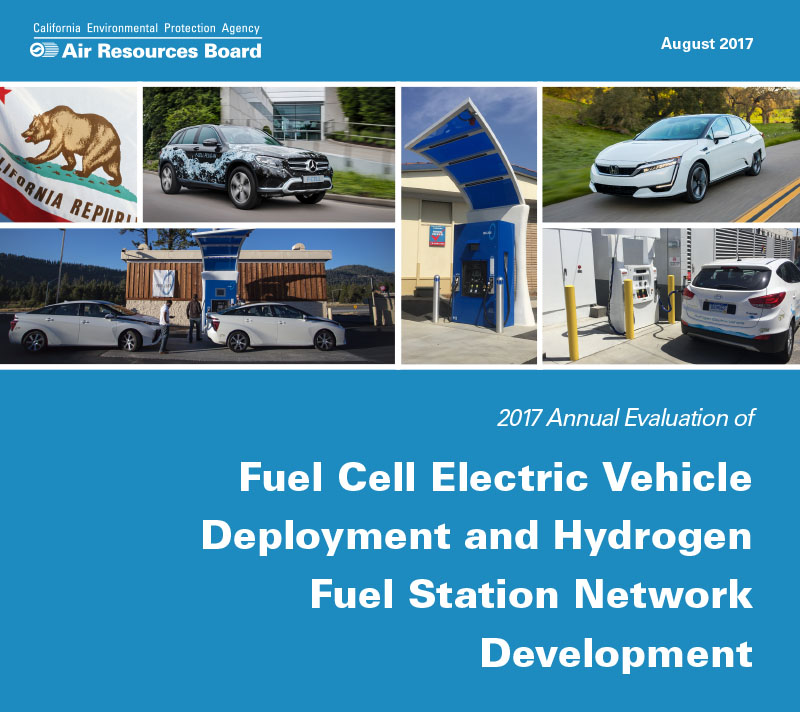The California Air Resources Board released its 2017 Annual Evaluation of Fuel Cell Electric Vehicle Deployment and Hydrogen Fuel Station Network Development that documents the growth in hydrogen stations and FCEVs since mid-2016. On August 29 CaFCP hosted a webinar about the report.

Key findings include:
- California’s hydrogen fueling and FCEV markets have transitioned from a pre-commercial to an early commercial phase.
- The Hydrogen Station Equipment Performance (HyStEP) device helped accelerate and streamline confirmation of hydrogen stations’ ability to fill vehicles per industry-developed standard protocols.
- Three commercial-era production FCEV models are on California’s roads and at least three more are expected. In April 2017, 1,600 FCEVs were on California’s roads. (By July, more than 2,300 cars were on the road.)
- In July, 29 retail hydrogen stations were open. (As of mid-August, the number of stations is 30). ARB projects a total of 34 retail stations to be open by the end of the year.
- FCEV deployment and station development are mutually dependent. Automakers adjusted their forecasts of future FCEV deployment to match the current pace of hydrogen station network development. If station development is accelerated, then automakers may make an upward adjustment to forecasts in future reports.
AB 8 Presentation PDF
AB 8 Presentation Video Recording
August 2017 AB8 Report Webinar - Questions and Answers
*Please note that most answers are from the text in the report
What are the reasons for the difference between actual registration numbers and vehicle projection numbers?
The automaker survey asks for projections more than a year in advance. The AB8 report projects all vehicle deployments will take place in Q1 of the calendar year. Actual deployment is different, and the report includes sales data through April. We won’t know the real difference between actual and projected until January 2018. (Page 27)
What's the expected usable life of the CHIT/CHAT model?
The model is constantly evolving to be able to identify areas that need hydrogen stations for coverage. (Page 50)
The 2012 A California Road Map defined coverage as “a local network by placing adequate fueling outlets in key markets.” CHIT is a free tool that any region of the world can adapt for its own use.
Can the overall time to get a station through the cycle of awarding to online status be shortened?
With each new award of hydrogen stations from the CEC’s ARFVTP, the timeline from award to open gets shorter. The Energy Commission is actively investigating alternative funding mechanisms to enable networkwide acceleration of growth; the ARB has begun parallel preliminary exploration of additional concepts. CEC seeking input about:
- Leveraging complementary investment and funding opportunities within the state
- Lowering perceived risk for private investors
- Increasing the private funds leveraged per State dollar invested
- Maintaining a more constant availability of State funds
- Incentivizing renewable hydrogen throughput
- Building hydrogen fueling demand
- Supporting development of more-competitive market dynamics in areas with sufficient grant-funded and/or private development
- Maintaining grant funding options in situations where they are more appropriate
(Page 67)
What happens to funds for stations not completed on time?
Depending on the rules in the PON, funding may be reallocated within ARFVTP and may be included in future hydrogen funding opportunities.
Will the CVRP program be refunded?
The California State Legislature must approve funding for the rebate program. ARB assumes that legislature will approve funding as they’ve done in previous years.
What is the probability of the amount of the rebate changing?
CaFCP hasn’t seen any proposals to change the amount of the rebate.
What are plans to make the vehicles and fuel more affordable for low-income communities?
Providing zero-emission vehicles in disadvantaged areas is a priority for the State of California. (Senate Bill 535) The CVRP does provide a higher rebate amount for people in disadvantaged communities.
How many vehicles can each hydrogen station fuel?
In 2009, CaFCP created an action plan for hydrogen station deployment. The plan started with an automaker survey of the number of projected vehicles (the same survey that ARB conducts for the AB8 report). To estimate the number of stations needed to support the cars, we assumed that each car would use .7 kg/day of fuel. Our estimate of 3,442 vehicles would need 2,410 kg/day of fuel.
This is not a realistic scenario because people do not drive and get fuel this way. Coverage—providing multiple fueling locations in a market—is more important than hydrogen capacity in these early years. The math of .7 kg/day per vehicle is still the math ARB and other stakeholders use when estimating hydrogen demand in the future.
Are hydrogen producers at full capacity or can they scale up production?
It’s unknown. Merchant and industrial hydrogen producers aren’t required to report capacity, plus industrial producers at refineries may be able to shift capacity from gasoline to hydrogen in the future. (Page 69) CaFCP members are starting to explore this topic.
What is the timeline for renewable production?
The Energy Commission has started exploring the funding of an in-state hydrogen production facility with emphasis on renewable hydrogen implementation. ARB supports the Energy Commission’s ongoing work towards a solicitation for a renewable hydrogen production facility in California. (Page 70)
Of the renewable powered facilities, how many are powered by solar, wind, or other?
Currently, renewable hydrogen production is at the point of use. Some stations make hydrogen from solar electrolysis at the station. A few stationary fuel cells make hydrogen from biogas (methane) and biomass (agricultural waste.)
Does steam methane reforming with full carbon capture count as renewable?
Only if it’s using biogas.
What are the plans for fueling trucks?
The AB8 report is specific to light-duty vehicles, but the Air Resources Board is separately investigating and has plans to fund stations for heavy-duty fuel cell vehicles. Please see CaFCP’s Medium- and Heavy-Duty Action Plan for more information about fuel cell trucks.